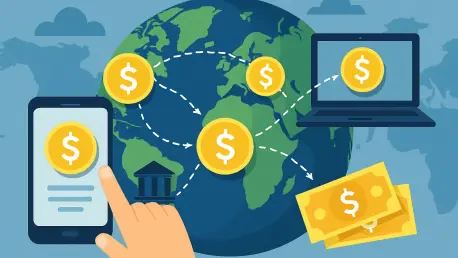In a world where a small business in rural India can sell handmade goods to a customer in New York with just a few clicks, cross-border payments have become the silent engine driving global trade. The market for these transactions, already valued at billions, is transforming how money moves across borders, breaking down barriers that once seemed insurmountable. What fuels this financial revolution, and how does it impact businesses, consumers, and economies on a global scale? This exploration dives into the heart of a system that’s reshaping commerce, revealing the trends, challenges, and real stories behind the numbers.
The Sudden Spotlight on International Transactions
Cross-border payments have surged into focus as globalization and digital connectivity accelerate at an unprecedented pace. With the market projected to grow from its current valuation to USD 2,235 million by 2031, a compound annual growth rate (CAGR) of 5.9% from 2025 onward highlights the escalating demand for seamless international transfers. This isn’t merely about moving money; it’s about enabling a hyper-connected economy where transactions fuel everything from personal remittances to sprawling multinational supply chains.
The urgency around this topic stems from the digital era’s demands. As e-commerce platforms expand and migrant workers send earnings home, the need for fast, secure, and affordable payment systems has never been clearer. Governments, businesses, and tech innovators are racing to keep up, recognizing that these financial conduits are no longer optional but essential to economic progress.
The Foundation of a World Without Financial Borders
At the core of today’s global economy lies the ability to transfer funds across nations effortlessly. Cross-border payments underpin vital activities, such as enabling businesses to settle with overseas suppliers, supporting families through remittances, and allowing consumers to shop from international online stores. This infrastructure isn’t a luxury but a critical component for millions who rely on it daily to navigate an interconnected world.
The significance of this system is evident in its scope. From small-scale personal transfers to large corporate dealings, the diversity of users underscores its role as a lifeline. As digital tools continue to evolve, they promise to make these transactions even more efficient, ensuring that geographical boundaries do not hinder economic participation or growth.
Forces Fueling the Payment Transformation
Several dynamic trends are propelling the evolution of cross-border payments, each contributing to a rapidly changing landscape. Digital transformation stands out, with fintech solutions slashing costs and speeding up processes through innovations like mobile wallets and real-time transfers. Meanwhile, the boom in global e-commerce demands robust systems to manage multi-currency transactions and combat fraud, as seen with major platforms connecting buyers and sellers worldwide.
Regulatory frameworks add another layer of complexity and trust, enforcing anti-money laundering standards and data protection laws to secure user confidence. Diverse needs—ranging from business-to-business transfers to individual remittances—drive tailored solutions, while regional differences shape growth patterns, with North America leading in innovation and Asia-Pacific surging due to high transaction volumes. These combined forces are redefining how money flows across the globe, positioning this sector as a pivotal player in modern trade.
Real Voices Behind the Financial Shift
Beyond statistics, the impact of cross-border payments comes alive through the experiences of those who use them. Industry leaders from prominent fintech firms have noted that speed and transparency are now baseline expectations, pushing companies to prioritize user-focused innovations. This sentiment reflects a broader shift toward customer satisfaction as a competitive edge in the market.
On the ground, stories of transformation abound. A small entrepreneur in Southeast Asia recently shared how adopting digital payment platforms reduced transaction fees by 30%, empowering them to rival larger competitors on a global stage. Such accounts, paired with market projections reaching USD 2,235 million by 2031, illustrate a dual narrative of technological advancement and tangible human benefit, grounding the data in real-world relevance.
Charting the Path Forward with Strategic Moves
Navigating the potential of cross-border payments demands practical approaches for businesses, consumers, and policymakers alike. Embracing digital tools offers a starting point, with platforms providing cost-effective solutions for both small transfers and personal remittances. Understanding regional preferences also proves crucial—mobile payment integration thrives in Asia-Pacific, while North American markets emphasize stringent security compliance.
Collaboration with providers equipped for regulatory adherence can simplify international dealings, ensuring seamless legal operations. For e-commerce, integrating localized payment options boosts customer trust, while consistently reviewing fee structures helps maintain affordability for frequent transactions. These steps collectively enable stakeholders to leverage this financial wave, fostering growth and connectivity in a borderless economic landscape.
Reflecting on a Transformative Journey
Looking back, the evolution of cross-border payments marked a turning point in how global commerce unfolded. The strides made in digital innovation and regulatory alignment laid a foundation for unprecedented connectivity, empowering individuals and enterprises alike to transcend borders with ease. Each advancement, from fintech breakthroughs to tailored user solutions, contributed to a more inclusive economic framework.
As this journey progressed, the focus shifted toward actionable next steps. Stakeholders began prioritizing scalable technologies and strategic partnerships to address lingering challenges like regulatory disparities and operational costs. The path ahead pointed to deeper integration of advanced tools, ensuring that the momentum of this financial revolution continued to bridge gaps and drive prosperity across nations.









